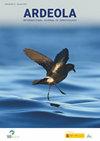远离家乡的觅食:地中海风暴海燕Hydrobates pelagicus melitensis的gps追踪揭示了远距离觅食运动
IF 1.2
4区 生物学
Q2 ORNITHOLOGY
引用次数: 6
摘要
总结。确定重要的觅食区域是探测物种的人口驱动因素并最终制定保护措施的基础。对一些物种来说,比如小型远洋海鸟,觅食地很难定位,基本上不为人知。我们使用小型GPS设备(~ 0.95g)研究地中海风暴海燕在孵化期间的觅食运动。在贝尼多姆殖民地(地中海西南部)的一次觅食旅行中,总共追踪了43只个体。我们首先评估了跟踪设备的潜在负面影响。我们记录了22次完整的觅食行程,并测量了它们的家园范围、觅食区域和个体之间的重叠程度。我们使用首次通过时间分析(FPT)来区分觅食/休息与飞行/旅行活动,并推断潜在的觅食区域。所有被追踪到的鸟都回到了它们的栖息地。平均而言,在觅食旅行后,个体体重略有下降,这表明该设备的直接负面影响很小。追踪鸟的繁殖成功率较高(0.71)。觅食行程持续1 ~ 4.5天,总行程在303.14 ~ 1726.53公里之间。被访问的地区覆盖了整个地中海西南部。被追踪的个体共享超过50%的家园范围。觅食区域位于阿尔博兰海和卡塔赫纳峡谷的深海区域,比之前认为的距离殖民地更远(从240公里到469公里)。为了确定该物种的重要海洋区域,需要进一步的研究来确定其他生命周期时期的觅食地,并每年评估可重复性。——rotger, A, Sola, A, Tavecchia, G. & Sanz-Aguilar, A.(2021)。远离家乡的觅食:地中海风暴海燕的gps追踪揭示了远距离觅食的运动。阿尔迪奥拉,68:3-16。本文章由计算机程序翻译,如有差异,请以英文原文为准。
Foraging Far from Home: Gps-Tracking of Mediterranean Storm-Petrels Hydrobates pelagicus melitensis Reveals Long-Distance Foraging Movements
Summary. Identifying important foraging areas is fundamental to detecting the demographic drivers of a species and ultimately to plan conservation measures. For some species, such as small pelagic seabirds, foraging grounds are difficult to locate and remain largely unknown. We used miniaturised GPS devices (∼0.95g) to study foraging movements of Mediterranean Storm-petrels Hydrobates pelagicus melitensis during the incubation period. A total of 43 individuals at Benidorm colony (southwestern Mediterranean Sea) were tracked during a single foraging trip. We first assessed potential negative effects of the tracking devices. We recorded 22 complete foraging trips and measured home-range, foraging areas and the degree of overlap among individuals. We used first passage time analyses (FPT) to differentiate foraging/resting from flying/travelling activities and to infer potential foraging areas. All tracked birds returned to the colony. On average, individual body weight slightly decreased after foraging trips, suggesting a small immediate negative effect of the device. Tracked birds had high breeding success (0.71). Foraging trips lasted between 1 and 4.5 days with the total distance travelled ranging between 303.14 and 1,726.53km. The visited areas covered the whole south-western part of the Mediterranean Sea. Tracked individuals shared more than 50% of their home-range areas. Foraging areas were located further from the colony than previously thought (from 240 to 469km away) on deep sea areas of the Alboran Sea and Cartagena Canyons. Further studies are needed to locate foraging grounds during other life-cycle periods and to evaluate repeatability yearly, in order to determine the important marine areas for the species.—Rotger, A., Sola, A., Tavecchia, G. & Sanz-Aguilar, A. (2021). Foraging far from home: GPS-tracking of Mediterranean Storm-petrels Hydrobates pelagicus melitensis reveals long-distance foraging movements. Ardeola, 68: 3-16.
求助全文
通过发布文献求助,成功后即可免费获取论文全文。
去求助
来源期刊
CiteScore
2.30
自引率
6.20%
发文量
16
审稿时长
>12 weeks
期刊介绍:
Ardeola: International Journal of Ornithology is the scientific journal of SEO/BirdLife, the Spanish Ornithological Society. The journal had a regional focus when it was first published, in 1954. Since then, and particular during the past two decades, the journal has expanded its thematic and geographical scope. It is now a fully international forum for research on all aspects of ornithology. We thus welcome studies within the fields of basic biology, ecology, behaviour, conservation and biogeography, especially those arising from hypothesis-based research. Although we have a long publication history of Mediterranean and Neotropical studies, we accept papers on investigations worldwide.
Each volume of Ardeola has two parts, published annually in January and July. The main body of each issue comprises full-length original articles (Papersand Review articles) and shorter notes on methodology or stimulating findings (Short Communications). The publication language is English, with summaries, figure legends and table captions also in Spanish. Ardeolaalso publishes critical Book Reviewsand PhD-Dissertation Summaries; summarising ornithological theses defended in Spain. Finally there are two Spanish-language sections, Ornithological News; summarising significant recent observations of birds in Spain, and Observations of Rare Birds in Spain, the annual reports of the Spanish Rarities Committee.

 求助内容:
求助内容: 应助结果提醒方式:
应助结果提醒方式:


